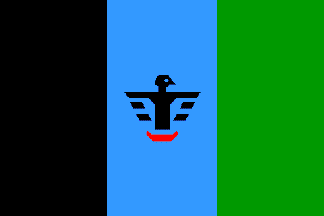 klaus-michael schneider
klaus-michael schneider
Keywords: zulia | lagunillas | ciudad ojeda |
Links: FOTW homepage | search | disclaimer and copyright | write us | mirrors

Last modified: 2021-08-26 by  klaus-michael schneider
klaus-michael schneider
Keywords: zulia | lagunillas | ciudad ojeda |
Links: FOTW homepage |
search |
disclaimer and copyright |
write us |
mirrors

image by Andrés González,
Wikimedia Commons, 24 July 2015
See also:
The municipality of Lagunillas (239,284 inhabitants in 2012; 975 sq. km) is
located on the eastern coast of Lake Maracaibo.
Lagunillas is named for small lagunas ("lagunillas") formed by the flood of Lake
Maracaibo during the rainy season. The village of Nuestra Señora de la
Concepción de Lagunillas was established in 1730, to be renamed in 1774 Nuestra
Señora de La Candelaria de Las Lagunillas. Visited that year by Bishop Mariano
Marti Stadella, the village counted 291 inhabitants forming 64 households living
in 38 huts built on piles.
The first Law on Territorial Division, adopted on 28 April 1856 by the Congress
of the Republic of Venezuela, divided the Province of Maracaibo in five Cantons
and 26 Parishes. The Parish of Lagunillas was part of the Canton of Altagracia.
The social unrest that lasted from 1858 to 1863 prevented the implementation of
the divisions, which were eventually established after peace had been restored,
with a few territorial modifications. A Decree adopted on 23 January 1895 by the
Legislative Assembly of the State of Zulia fixed the limits of the Parish of
Lagunillas.
Lagunillas entered in modern era in 1925-1926, when the Venezuelan Gulf Oil
performed the first oil drillings. Oil was subsequently extracted by the Lago
Petroleum Co. and the Venezuelan Oil Concessions Ltd (VOC). Oil industry
attracted migrants, who lived in huts anarchically established on floating
wooden platforms. During the rainy season, the settlement was totally flooded;
the path connecting it to the nearest villages, Tasajeras and Las Morochas, was
transformed into a marsh that could be crossed only with small boats. The oil
companies erected a contention wall to protect the oil plants from flooding.
On 19 January 1937, President Eleazar López Contreras ordered the building of
the town of Ciudad Ojeda to relocate the inhabitants of Lagunillas, who still
lived in unsafe conditions. Named for Alonso de Ojeda, the discoverer of Lake
Maracaibo, the new town was inaugurated on 9 July 1939. On 13 November 1939, a
big blaze suppressed the old town of Lagunillas, claiming more than 200 lives.
Source:
http://www.monografias.com/trabajos69/historia-municipio-lagunillas/historia-municipio-lagunillas.shtml
- "Conoce la Historia del Municipio Lagunillas (Venezuela)", by Francisco
Antonio Chávez Yunez
Ivan Sache, 24 July 2015
Flag of Lagunillas municipality (capital town: Ciudad Ojeda)
at <lagunillas-zulia.gob.ve>.
Dov Gutterman, 3 June 2005
The flag of Lagunillas is vertically divided black, symbolizing the resources
in oil, celestial blue, symbolizing the water of Lake Maracaibo, and green,
symbolizing the resources of agriculture and cattle-breeding. In the center of
the flag is placed a stylized representation of the legendary phoenix bird
rising from its ashes. The phenix represents the municipal capital, Ciudad Ojeda,
established after a blaze had destroyed the old village of Lagunillas,
symbolized by the fire placed beneath the bird.
The flag, unanimously adopted on 20 April 1982 by the Municipal Council, was
amended in November 2000. It appears that the phenix emblem was originally
placed on a yellow oval .
Sources:
https://lagunillasdigital.wordpress.com/la-bandera-municipal/ - "La bandera
municipal", by Omar Bracho, Municipal Chronicler (original description)
http://www.corpozulia.gob.ve/archivos/LAGUNILLAS_2010-2011.pdf - "Municipio
Lagunillas", official presentation (amended description)
Ivan Sache, 24 July 2015
v-la.jpg)
from <lagunillas-zulia.gob.ve>